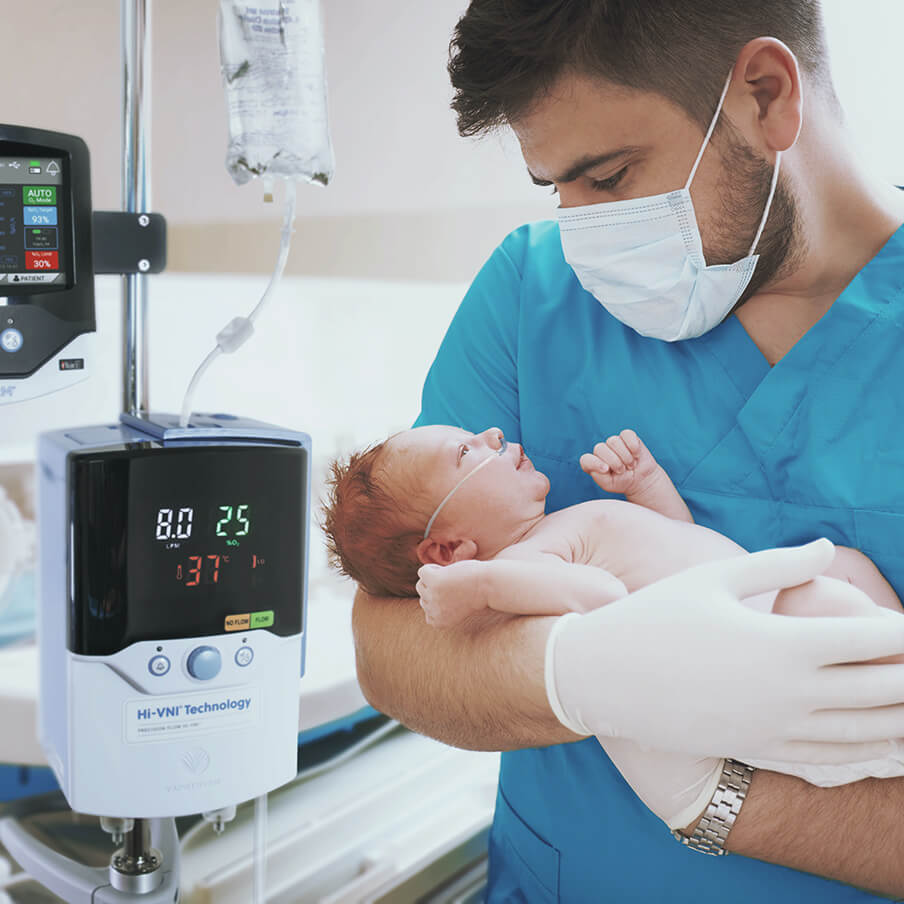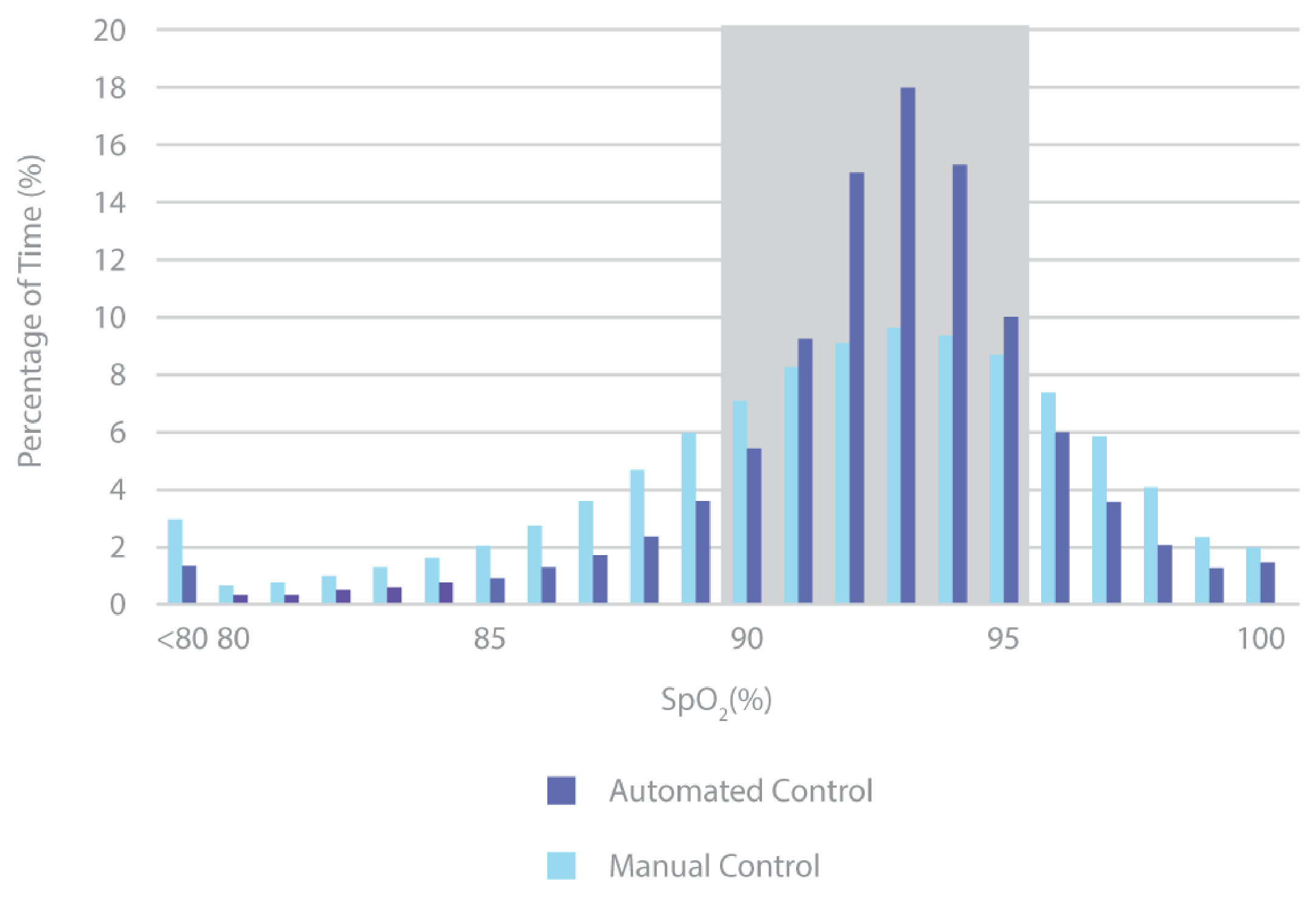Oxygen Assist Module (OAM)
The Automatic Oxygen Controller for Vapotherm’s Precision Flow® System
Not available in all markets.

When Precise Oxygen
Control Is Essential
- OAM assists staff in maintaining SpO2
- When compared to manual control, OAM automated control can keep your patient in the target SpO2 range for a greater proportion of time [1]

From Premature Neonates To Adult Covid-19 Patients
Keeping your patients‘ SpO2 in range is crucial in avoiding clinical consequences of too high or too low SpO2, such as retinopathy of prematurity (ROP) in neonates, or pulmonary damage or vasoconstriction [2] in certain critically ill adult populations.
Guidelines call for COVID-19 patients’ SpO2 target range ideally between 92-96%. [3] Keeping your COVID-19 patients in this narrow target range can be demanding, often requiring frequent manual adjustments to the FiO2. But OAM can help you improve oxygen control and meet your patients’ oxygen demands as they fight the disease and help improve their mortality outcomes. [4]
More Time In Range. More Time To Care.

Figure 2, adapted from Reynolds et al 2019 shows that in neonates, OAM automated control maintained the babies’ SpO2 in the target SpO2 range significantly more effectively than manual control, and reduced the duration of hypoxic and hyperemic episodes. [1]
- Precise control of FiO2 delivery
- Fast and easy set up
- May reduce time in SpO2 alarms and noise due to SpO2 alarms
- Facilitates kangaroo care of neonates without bulky interfaces
- May reduce the amount of manual FiO2 adjustments needed, and allow nurses to spend more time with patients and families
Safe. Sophisticated. Simple.
Product simplicity and safety features give providers the option to confidently and easily control automated oxygen delivery:
- Full compatibility with Vapotherm Precision Flow Systems*
- Integrated patient safety alarms
- Convenient touch screen display on OAM
- Connection to nurse call
- Uses Masimo SET® Measure through Motion and Low Perfusion™ pulse oximetry and Medtronic Nellcor™ OxiMax™ pulse oximetry
- Easy one-button control on the Precision Flow System
- Sophisticated trend views
- The Precision Flow System is incubator safe and all components are safe to touch without burn risk
- Large LCD screen conveniently displays selected therapy parameters
Product Specifications
Tech Specs
Compatible with all air/oxygen Precision Flow systems with software version 3.8.3 and above.
Uses Masimo SET® Measure through Motion and Low Perfusion™ pulse oximetry and Medtronic Nellcor™ OxiMax™ pulse oximetry.
Compatible Consumables
- Vapotherm Disposable Patient Circuits
- Vapotherm Nasal Cannulas
- Masimo LNCS® Adhesive Sensors, LNCS® Neo-3 Adhesive Sensor, and RD SET™ Sensors (Provided by Masimo®) and Medtronic Nellcor™ OxiMax™ pulse oximetry
Connectivity
3 pin 3.5 mm stereo audio jack for Nurse Call connection with three adapter cables available.
* Compatible with all air/oxygen Precision Flow systems with software version 3.8.3 and above.
CAUTION: US Federal law restricts this device to sale by or on the order of a physician. Indications, contraindications, warnings, and instructions for use can be found in the product labelling supplied with each device or at https://vapotherm.com/resources/support/precision-flow-reference/. For spontaneously breathing patients. High Velocity Therapy (HVT) does not provide total ventilatory requirements of the patient. It is not a ventilator. Decisions surrounding patient care depend on the physician’s professional judgment in consideration of all available information for the individual case, including escalation of care depending on patient condition.
SOURCES: [1] Reynolds P, et al. Randomised cross-over study of automated oxygen control for preterm infants receiving nasal high flow. Arch Dis Child Fetal Neonatal Ed. 2019 Jul;104(4):F366-F371. [2] Vincent JL, et al. Harmful Effects of Hyperoxia in Postcardiac Arrest, Sepsis, Traumatic Brain Injury, or Stroke: The Importance of Individualized Oxygen Therapy in Critically Ill Patients. CRJ. 26 Jan 2017. [3] Alhazzani W, Moller MH, Arabi YM, et al. Surviving Sepsis Campaign: Guidelines on the Management of Critically Ill Adults with Coronavirus Disease 2019 (COVID-19). Critical care medicine. 2020;PREPUBLICATION. [4] Centers for Disease Control and Prevention. Clinical Management of Critically Ill Adults with COVID-19. Clinician Outreach and Communication Activity Webinar. Thursday, April 2, 2020